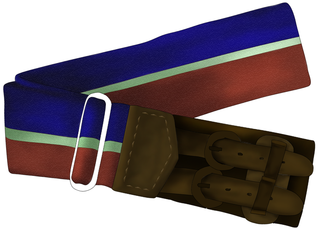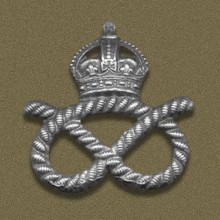
Yeomanry is a designation used by a number of units or sub-units of the British Army Reserve, descended from volunteer cavalry regiments. Today, Yeomanry units serve in a variety of different military roles.

A stable belt is a striped colored belt worn at times by the armed forces of the United Kingdom and other Commonwealth countries - and few other countries such as Denmark, Brazil and Lebanon. The stripes identify and vary by regiment and corps. In Brazil and Lebanon they are known as gymnastic belts.
Options for Change was a restructuring of the British Armed Forces in 1990 after the end of the Cold War.

The Royal Yeomanry (RY) is the senior reserve light cavalry regiment of the British Army. Equipped with Supacat Jackal variants and the Land Rover RWMIK, their role is to conduct mounted and dismounted formation reconnaissance. The Regimental Headquarters is located in Leicester, with squadrons in Fulham, Nottingham, Dudley, Croydon, Telford and Leicester.

The Royal Wessex Yeomanry (RWxY) is a Reserve armoured regiment of the British Army Reserve consisting of five squadrons. Formerly part of 43 (Wessex) Brigade, the regiment joined 3rd (UK) Division in July 2014, to provide armoured resilience to the three armoured regiments within the Reaction Force. In 2015 the Regiment was moved from the Operational Command of 3rd (UK) Division to 1st Armoured Infantry Brigade, but members of the Regiment still wear the 3rd (UK) Division formation badge to reflect their role in supporting the three Armoured Regiments in the Division.

The Queen's Own Yeomanry (QOY) is one of the Army Reserve light armoured reconnaissance regiments.

The Sherwood Rangers Yeomanry (SRY) is one of the six squadrons of the Royal Yeomanry (RY), a light cavalry regiment of the Army Reserve. Designated as 'A' Squadron, the Sherwood Rangers Yeomanry's current role is to support the Light Cavalry Regiments on operations by providing skilled reconnaissance soldiers.
Precedence is the order in which the various corps of the British Army parade, from right to left, with the unit at the extreme right being highest.

The Staffordshire Yeomanry was a unit of the British Army. Raised in 1794 following Prime Minister William Pitt's order to raise volunteer bodies of men to defend Great Britain from foreign invasion, the Staffordshire Yeomanry began as a volunteer cavalry regiment.
The Queens Own Warwickshire & Worcestershire Yeomanry was a regiment of the Territorial Army, formed in 1956 by the amalgamation of the Warwickshire Yeomanry and the Queen's Own Worcestershire Hussars. It was broken up in 1971.
The Warwickshire Yeomanry was a yeomanry regiment of the British Army, first raised in 1794, which served as cavalry and machine gunners in the First World War and as a cavalry and an armoured regiment in the Second World War, before being amalgamated into the Queen's Own Warwickshire and Worcestershire Yeomanry in 1956. The lineage is maintained by B Squadron, part of The Royal Yeomanry.
The Queen's Own Mercian Yeomanry was a cavalry regiment of the Territorial Army, formed in 1971 by the reconstitution of squadrons from the Queen's Own Warwickshire and Worcestershire Yeomanry, the Staffordshire Yeomanry and the Shropshire Yeomanry. It amalgamated into the Royal Mercian and Lancastrian Yeomanry in 1992.

The Home Service Force was a Home Guard type force established in the United Kingdom in 1982. Each HSF unit was placed with either a Regular Army or Territorial Army regiment or battalion for administrative purposes and given that formation’s title, cap badge and recruited from volunteers aged 18–60 with previous British forces experience. It was introduced to guard key points and installations likely to be the target of enemy special forces and saboteurs, so releasing other units for mobile defence roles. It was stood down in 1992.

The Duke of Lancaster's Own Yeomanry was a British Army regiment that existed from 1798 to 1992. The regiment sent mounted infantry for service in the Second Boer War as the Imperial Yeomanry, between 1900 and 1902, and also saw action during the First and Second World Wars. Its lineage is maintained by B Squadron, the Queen's Own Yeomanry.

The Queen's Own Worcestershire Hussars was a Yeomanry regiment of the British Army. First raised in 1794, it participated in the Second Boer War and World War I as horsed cavalry before being converted to an anti-tank regiment of the Royal Artillery for service in World War II. In 1956 it was amalgamated with the Warwickshire Yeomanry to form the Queen's Own Warwickshire and Worcestershire Yeomanry. The lineage is maintained by B Squadron, part of The Royal Yeomanry.
Armoured regiments are units provided by the Royal Armoured Corps of the British Army.
During the First World War the British Armed Forces was enlarged to many times its peacetime strength. This was done mainly by adding new battalions to existing regiments. Although sometimes identified by shoulder titles, generally the new battalions could not be identified from appearance. Consequently, the units in this list have been assembled considering only those as having a uniquely different cap badge.











